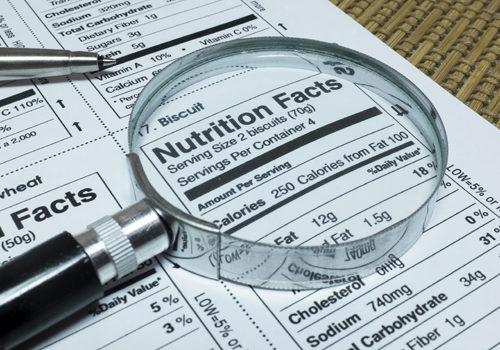When you read a supplement or grocery product label, you’ll likely find Supplement or Nutrition Facts stating the nutritional content of the product per serving and how much (on a percentage basis) it contains of the daily value. While it may seem straightforward, there’s a lot more to these numbers than meets the eye.
Nailing the Terminology
There are two sets of reference values for nutrition labeling intended to guide you to reaching proper nutrient balance from your food and supplements: Daily Reference Values (DRVs) and Reference Daily Intakes (RDIs) (1).
The terminology has been changed and updated over the years. Established by the predecessor to the U.S. Food and Drug Administration (FDA), during World War II, the original Recommended Daily Allowances (RDAs) were sets of norms established to provide nutritional guidelines as to how people could stay fit and healthy—an important thing to consider in wartime. These RDAs were revised every decade until 1997, when they became part of a larger set of guidelines called the Dietary Reference Intake (DRIs) used in the United States and Canada (2). DRIs are developed by the Institute of Medicine, and relate to both adequate intakes and upper levels of intakes, which we’ll describe later.
The DRIs are more comprehensive than their predecessors, providing specific recommendations by gender and age as well as other statistics for those trying to meet nutritional needs. DRVs are used for total fat, saturated fat, cholesterol, total carbohydrate, dietary fiber, sodium, potassium and protein content; RDIs are used for vitamins and minerals (and for protein for children less than four and for pregnant/lactating women). DRVs and RDIs are both called “Daily Value” on product labels, for simplicity.
Here’s how this all works for a product containing 20 mg of vitamin C per serving, for instance. Since the RDI of vitamin C is 60 mg, the product will say that it contains 33% of the Daily Value (i.e., the total amount experts believe we need daily). The levels of nutrients laid out in DRVs and RDIs are intended to meet the nutritional demands of 97–98% of the population, based on the DRIs from the Institute of Medicine.
Specific DRIs for various vitamins and minerals are available on several government Web sites, including:
• www.iom.edu/Global/News%20Announcements/DRI.aspx
• www.nutrition.gov/smart-nutrition-101/dietary-reference-intakes-rdas
More to the Story
Read the number on the label and know what nutrients you need; sounds simple enough, right? Keep reading.
While they are backed by scientific research, at the end of the day, DRIs are guidelines for consumers. There is a misconception that the Daily Value on a product label is the maximum you should consume, and taking in any more would be unhealthy.
In many cases, almost the opposite is true. The recommended Daily Values are simply the baseline amounts needed for healthy function in most people. The Institute of Medicine feels the amounts suggested are “adequate” for this purpose. But, the levels don’t account for those who may have greater nutritional demands in some areas due to genetics, taking medication that deplete the body’s nutrient stores, having an illness that causes malnourishment or other reasons.
DRIs attempt to account for this with figures like the Estimated Average Requirements (EAR), which aim to indicate the nutritional needs of half of a certain age group, and the Tolerable Upper Level (UL), which are designed to set limits for vitamins that can be toxic if consumed in high amounts.
There are also some nutrients that have been proven to be important with regard to health that don’t even have an established daily value, such as omega-3s. On a product label, you will see the amount of EPA/DHA per serving, for instance, and merely a footnote stating that the Daily Value has yet to be established.
In addition, many nutritionists are concerned that several DRIs are too low, and have called on the Institute of Medicine to revise and raise these amounts. In some cases, the values for certain nutrients are even far below the UL. One example of this is vitamin B6, where the average person can take over 50 times the RDI and still not come close to the UL (3).
Vitamin D is another prominent case. Even though its RDI was raised in 2010 to 600 international units (IUs) in people ages 1–70, several industry experts still consider the increase to be insufficient. Scientific evidence was cited to show that 1,000–4,000 IUs was closer to an ideal dosage, with up to 10,000 IU being deemed safe by many experts. The current UL for vitamin D is 2,000-4,000 IUs (4). With this said, there are some nutrients like vitamin A where the gap is closer, as three times the RDI for vitamin A exceeds its UL. Always see a doctor before exceeding the recommended daily value or UL for any nutrient. WF
Additional Consumer Bulletins are available at www.wholefoodsmagazine.com/columns/consumer-bulletin
References
1. FDA, “Guidance for Industry: A Food Labeling Guide (14. Appendix F: Calculate the Percent Daily Value for the Appropriate Nutrients),” January 2013, www.fda.gov/Food/GuidanceRegulation/GuidanceDocumentsRegulatoryInformation/LabelingNutrition/ucm064928.htm, accessed Dec. 10, 2014.
2. Institute of Medicine, “Dietary Reference Intakes Tables and Application,” www.iom.edu/Global/News%20Announcements/DRI.aspx, accessed Dec. 10, 2014.4. 3. WebMD, “Vitamins and 3. Minerals: How Much Should You Take?” www.webmd.com/vitamins-and-supplements/lifestyle-guide-11/vitamins-minerals-how-much-should-you-take?page=2, accessed 11/21/14.
4. WholeFoods Magazine, “The Many Faces of Vitamin D,” February 2011, www.wholefoodsmagazine.com/columns/consumer-bulletin/many-faces-vitamin-d, accessed 11/21/2014.
Published in WholeFoods Magazine, January 2015











